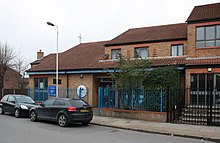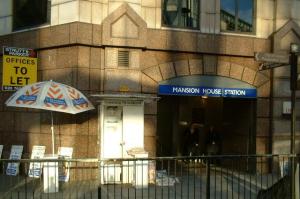
St Matthias' Church is a Church of England parish church in Canning Town, east London. The modern building comprises a chapel, community rooms and a home for residents with disabilities.

St Matthias' Church is a Church of England parish church in Canning Town, east London. The modern building comprises a chapel, community rooms and a home for residents with disabilities.
The origins of St Matthias Church in Canning town are found in 1887 with a gospel mission from St Mary's Church, Plaistow. It was named after St Matthias' Church in Torquay, which had assisted with funding the mission.
In 1906 the mission merged with that of St Cyprian on Beaconsfield Road. In 1907 a permanent church building was built and a parish formed.
This parish contained sections of the parish of St Mary's, St Andrew's and St Gabriel's. In 1961 parts of the parish of Holy Trinity and more from St Gabriel's were added. With the three churches of St Mary's Church, St Martin's, and St Philip and St James’, it formed part of the Parish of the Divine Compassion. [1]
By 1989 the original church building was demolished and replaced in 1991 by an integrated chapel, community rooms and home for residents with disabilities. [2] [3] [4]
In 2016, St Matthias' Church received a planted congregation from neighbouring church All Hallows Bow at the invitation of the Bishop of Barking. [5] All Hallows had itself been the recipient of a church plant project in 2010 involving St Paul's Shadwell (itself the recipient of one from Holy Trinity Brompton in 2005) and has since seen significant growth. Details of this can be found in a report by The Centre for Theology & Community entitled 'Love, Sweat and Tears: Church Planting in East London'

William Butterfield was a British Gothic Revival architect and associated with the Oxford Movement. He is noted for his use of polychromy.

Sir Arthur William Blomfield was an English architect. He became president of the Architectural Association in 1861; a Fellow of the Royal Institute of British Architects in 1867 and vice-president of the RIBA in 1886. He was educated at Trinity College, Cambridge, where he studied Architecture.

St Michael's Church is the principal Anglican church for Camden Town in north London. The present building, built in the late 19th century, was designed by George Frederick Bodley and Thomas Garner in a Gothic Revival style.

The Diocese of Armagh is the metropolitan diocese of the ecclesiastical province of Armagh, the Church of Ireland province that covers the northern half (approximately) of the island of Ireland. The diocese mainly covers counties Louth, Tyrone and Armagh, and parts of Down. The diocesan bishop is also the Archbishop of Armagh, the archbishop of the province, and the Primate of All Ireland. The Archbishop has his seat in St Patrick's Cathedral in the town of Armagh.
Benjamin Ferrey FSA FRIBA was an English architect who worked mostly in the Gothic Revival.

The Worshipful Company of Parish Clerks is one of the Guilds of the City of London. It has no livery, because "in the 16th century, the Parish Clerks declined to take the Livery on the grounds that the surplice was older than the Livery and was the proper garb of members of the Company." It is not, therefore, technically a livery company although to all intents and purposes it acts as such. It is one of two such historic companies without livery, the other being the Company of Watermen and Lightermen.

Holy Trinity the Less was a parish church in Knightrider Street in the City of London, destroyed in the Great Fire of London. Following the fire the site was used for a Lutheran church, which was eventually demolished in 1871 to make way for Mansion House underground station.

St Gabriel Fenchurch was a parish church in the Langbourn Ward of the City of London, destroyed in the Great Fire of London and not rebuilt.

The City of London Cemetery and Crematorium is a cemetery and crematorium in the east of London. It is owned and operated by the City of London Corporation. It is designated Grade I on the Historic England National Register of Historic Parks and Gardens.

Holy Trinity Church, commonly known as Horwich Parish Church, is a Grade II listed building in Horwich, Greater Manchester, England. It is an active Church of England parish church and part of the Deane deanery in the archdeaconry of Bolton, diocese of Manchester. Holy Trinity Church is now part of the United Benefice of Horwich and Rivington, which includes the other two Anglican churches in Horwich, St Catherine's Church and St Elizabeth's Church, and Rivington Anglican Church.

St Mary's Church is a Church of England church in Plaistow in the (East-) London Borough of Newham. With the three churches of St Matthias’, St Martin's, and St Philip and St James’, it now forms part of the Parish of the Divine Compassion. Its Victorian building, designed by Sir Arthur William Blomfield in 1890-1894, was demolished in 1976. They now worship in a smaller church built in 1981.

St Philip and St James’ Church is a Church of England church in Plaistow, east London. It originated as two churches before being merged into the joint parish of St Philip and St James in 1955. That parish in its turn has now become part of the Parish of the Divine Compassion along with three other parishes in Plaistow and Canning Town - St Mary's, St Matthias' and St Martin's.

Holy Trinity Church was a Church of England parish church in Canning Town, east London. Its origins were in the Plaistow and Victoria Docks Mission, set up to serve the growing area of Hallsville by the vicar of St Mary's Church, Plaistow and Antonio Brady. It initially worshipped in the National School on Barking Road until the permanent church opened in 1867, with a parish formed for it the following year by parts of St Mary's and All Saints. Its advowson was initially vested in the bishop, but transferred to the Lord Chancellor in 1886 to allow the benefice of Holy Trinity to be supplemented from revenues from All Hallows Church, London Wall.
St Alban's Church, Upton Park is a Church of England church in the Upton Park area of East Ham in east London, England, dedicated to Saint Alban. It was founded by St Stephen's Church as a mission church on Boleyn Road in the Upton Park area around 1889, replaced by a small brick church on Wakefield Street in 1897. It was given a parish of its own in 1903, in which year the nave and aisle of a new permanent church on the opposite side of the same street were completed. Vestries, a Lady Chapel and chancel were added in 1934. Damaged by the London Blitz in 1940, it was repaired in 1949 and now forms part of the East Ham Team Parish alongside St Mary Magdalene's Church, St Bartholomew's Church and St Edmund's Church.

St Luke's Church, Canning Town or St Luke's Church, Victoria Docks is a Church of England church, originally housed in a building on Boyd Road in the Royal Docks area of West Ham in east London.
St Gabriel's Church, Canning Town was a Church of England church in Canning Town, east London. It originated as an undedicated iron church between the River Lea and the railway to the north of the Barking Road, on the site later used for the brick-built permanent church of St Gabriel's, consecrated in 1876. Initially a mission of All Saints Church, West Ham, it was given a parish of its own three years after the consecration, using parts of those of All Saints, St Mary's and St Andrew's. It was damaged in the London Blitz and demolished around 1955, with its parish split between St Matthias and St Luke's in 1961.
St Cedd's Church was a Church of England church between Newham Way, and Chadwin Road, in Canning Town, east London, dedicated to Cedd, evangelist to Essex, in whose ceremonial county the church falls. Opened as a brick hall in 1903-1904 as a mission of St Andrew's Church, Plaistow, it had a mission district assigned using parts of the parishes of St Andrew's and St Luke's in 1905. That mission district was turned into a separate parish in 1936, for which a new redbrick church was completed in 1939. Part of the former parish of Holy Trinity Church was assigned to St Cedd's in 1961, though the latter is no longer an Anglican church. Fire damaged in 1995, it was restored and re-opened in 2007 to house the London Ghana Seventh-day Adventist congregation

St Eleutherius, St Anthia and St Luke the Evangelist or the Greek Orthodox Community of St. Eleftherios and St. Luke is a Greek Orthodox church in Leyton, north London. It was founded in 1982 and since March 1984 it has been housed at 113 Ruckholt Road in what was originally St Luke's Church, a Church of England building. It is dedicated to Saints Eleutherius and Antia and Saint Luke.
{{cite web}}: CS1 maint: archived copy as title (link)